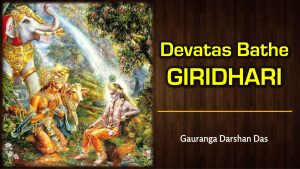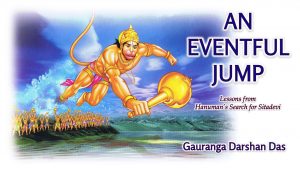THE BHAGAVATA PURANA
Its Glory and Summary
Gauranga Darshan Das
Śrīmad Bhāgavatam is the literary incarnation of Kṛṣṇa. After Kṛṣṇa left this world, He descended in the form of this book to give light in the darkness of this age of Kali. The Bhāgavatam is the masterpiece literature that gave complete satisfaction to the heart of its author, who wasn’t satisfied with his earlier works. The Bhāgavatam is considered the crown jewel of all scriptures, and the ripened fruit of the desire tree of all Vedic literatures (SB 1.1.3).
Śrīmad Bhāgavatam is a voluminous mahā-purāṇa consisting of 18,000 ślokas divided into 335 chapters and 12 cantos, that describe 10 topics namely – sarga (primary creation of the universe by the Lord), visarga (secondary creation by Brahmā and his sons), sthānam (universal cosmology), poṣaṇam (protection by the Lord), ūti (inclination to act), manvantara (reign of Manus, the fathers of mankind), īśānukatha (the stories of the Lord and His devotees), nirodha (destruction of the universe), mukti (liberation) and āśraya (the supreme shelter of Lord Kṛṣṇa) – that present essential guidelines for the spiritual wellbeing of humanity.
Despite having written rich literatures such as the Vedas, the Purāṇas and so on, Vyāsa felt an incompleteness at heart. It was then that his guru Nārada Muni came to him and suggested that he write Śrīmad-Bhāgavatam in a way that bhakti-yoga is repeatedly emphasized and Lord Kṛṣṇa’s qualities and activities are vividly described.
In the literatures that Vyāsa had written before, there was an overemphasis on the four puruṣārthas (goals of life) namely dharma (religious rituals), artha (money), kāma (desire for enjoyment) and mokṣa (liberation). Usually, people perform dharma to get artha and fulfill their kāma. And when they are frustrated in kāma, they think of mokṣa or getting rid of material life. But there is something more valuable and beyond these four – pañcama-puruṣārtha, the fifth goal of life which is prema or love of God, which can be developed only by selfless performance of bhakti. It is bhakti alone that gives a pure spirit soul unending spiritual joy in loving God. The Bhāgavatam’s emphasis on reaching prema through bhakti-yoga.
After writing the Bhāgavatam, Vyāsadeva taught it to his son Śukadeva Gosvāmī, who later narrated it to King Parīkṣit in seven days. By sincerely hearing, studying, and speaking the Bhāgavatam one develops pure love for Lord Kṛṣṇa, who becomes captivated in the heart of such a devotee.
Śrīla Prabhupāda, has established the International Society for Krishna Consciousness, based on the teachings of the Gīta and the Bhāgavatam. Although he had established over hundred temples across the globe, and toured the world over fourteen times in his stupendous efforts to spread bhakti-yoga, despite so much of management and outreach, so many disciples and travelling, he gave special importance to translating Śrīmad-Bhāgavatam into English and explaining it as per the needs of the modern world in his purports. While everyone was sleeping in the silence of the night, he would be awake, working on the book Bhāgavatam. Here is a brief outline of the entire Bhāgavatam.
The First Canto of Śrīmad-Bhāgavatam describes the supremacy of bhakti and categorically presents that Lord Krishna is the Supreme Personality of Godhead, through the conversation between Suta Gosvāmī and the Naimiṣāraṇya sages. Sūta Gosvāmī describes the birth and activities of Parikshit Maharaj who chastised even Kali personified. When Parikshit was cursed by Sringi to die in seven days, he heard the Bhagavatam from Śukadeva Gosvāmī. This canto vividly describes the exclusive dependence of the devotee on Krishna and Kṛṣṇa’s nature as bhakta-vatsala.
In the Second Canto, Śukadeva Gosvāmī describes the supremacy of bhakti yoga, while presenting various other process on the Vedic landscape, like devatā worship, meditation on virāṭ rūpa and paramātma as a part of Aṣṭānga yoga. He also describes the catuh-sloki bhāgavatam and defines the ten topics of Bhāgavatam. This canto establishes the supremacy of devotional service unto Kṛṣṇa as the topmost spiritual path for the entire humanity.
In the Third and Fourth Cantos, Śukadeva describes the creation of the universe done by the Lord, and the sub-creation done by Brahmā and his sons, Varāhadeva’s pastimes, teachings of Lord Kapila and the episodes of Dakṣa, Dhruva, Anga, Vena, Pṛthu, Prācinabarhi and the Pracetās – all as a part of the conversation between Maitreya and Vidura. The Third Canto elaborately describes how the Supreme Lord is the source and sustenance of the entire cosmos. Through the various prayers of pure devotees, the Fourth Canto establishes the superiority of bhakti over karma and jnana, and specifically the glory of the process of sravaṇam.
In the Fifth Canto Śukadeva Gosvāmī describes the dynasty of King Priyavrata and the geography of the universe – the positioning of its various planetary systems. The majesty and grandeur of the Lord’s creation is unfathomable for an ordinary human. It’s recommended that one faithfully adhere to scriptural teachings and pursue the spiritual path.
The Sixth Canto describes how the Supreme Lord protects His devotees (poṣaṇam) through the wonderful examples of Ajāmila, Indra, Citraketu and Vṛtrasura. Even if sometimes the devotees transgress the codes of dharma circumstantially, the Lord compassionately forgives and purifies them.
The Seventh Canto describes the pastimes of Lord Nṛsimha and His unalloyed devotee Prahlāda. This canto also describes various features of varṇāśrama dharma. While pure devotees like Prahlāda have full faith about the all-pervading nature of the Supreme Lord, atheists like Hiraṇyakaśipu arrogantly disbelieve even in the existence of God.
The Eighth Canto’s main topic is manvantara or the reigns of the fourteen manus in the current day of Brahmā. As a part of this description, we hear the episodes of Gajendra, Samudra Manthan, King Bali’s deliverance by Lord Vamana and the pastimes of Matsya avatāra. In all the episodes of this canto, the Lord’s protection aspect is vividly described.
The Ninth canto describes the dynasties of the sun and the moon. Some prominent kings of the sun dynasty were Sudyumna, Ambarīṣa, Sagara, Ikṣvāku and Lord Rāmacandra. And the moon dynasty has kings like Purūrava, Yayāti, Yadu etc., and Lord Kṛṣṇa appeared in this great dynasty. However glorious a dynasty may be, none of its members can forever enjoy its opulence. Only the devotional service one has rendered to the Lord with a sincere heart remains with the self as a permanent asset.
The Tenth and Eleventh cantos elaborately describe the appearance of Lord Kṛṣṇa, His pastimes in Vrindavan, Mathura, Dwaraka and Hastinapur, and also His teachings to Uddhava and His enigmatic disappearance. The nectar of tenth canto, especially the Vrindavan pastimes, constitute the most precious gift for the devotees to absorb themselves in love of Kṛṣṇa. The Mauṣala līla and the Uddhava Gīta teach us the temporary nature of this world.
In the Twelfth Canto, Śukadeva Gosvāmī describes the four types of pralaya or annihilation, and then King Parīkṣit attains liberation. In front of the great destructions or changes that happen at the end of a day and the life of Brahmā, the small losses we experience in the material world including death, are actually insignificant.
Śrīla Vṛndāvana Dāsa Ṭhākūra writes in the Caitanya Bhāgavata that no inauspiciousness can enter a house that has Śrīmad-Bhāgavatam. On the full moon day of Bhādra month, if one places Bhāgavatam on a golden throne and gives it as a gift, one surely attains the supreme destination.





Hare Krishna!!!
Dandvat Pranam!
Very nicely and briefly explained in simple language about my Gaby scripture, thanx a lot Prabhujee for your eloquent lectures and meaningful insight.
Jai well explained